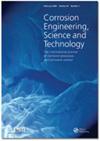化学镀镍金铜的局部水腐蚀
IF 1.5
4区 材料科学
Q4 MATERIALS SCIENCE, MULTIDISCIPLINARY
Corrosion Engineering, Science and Technology
Pub Date : 2022-08-18
DOI:10.1080/1478422X.2022.2096322
引用次数: 1
摘要
化学镀镍(Ni)浸金(Au),通常简称为ENIG,是印刷电路板(pcb)裸露的铜(Cu)迹线上最常用的保护涂层。在这项工作中,我们通过微观、表面分析和高空间分辨率的电化学技术来阐明enigg - cu体系的局部腐蚀机制,从而全面了解enigg - cu体系复杂的局部腐蚀机制。腐蚀起始是高度局部化的,并与金层中的孔隙或微缺陷有关。腐蚀是由下层镍层的溶解引起的,镍的贵重度低于金。溶蚀作用在相对于表面的横向和垂直方向上以椭圆方式传播。随着时间的推移,腐蚀扩展的方向以Ni层的侧向腐蚀为主。腐蚀过程受Au/Ni电偶的阴极/阳极比的控制。本文章由计算机程序翻译,如有差异,请以英文原文为准。
Localised aqueous corrosion of electroless nickel immersion gold-coated copper
ABSTRACT Electroless nickel (Ni) immersion gold (Au), commonly referred to by the acronym ENIG, is the most common protective coating applied on the exposed copper (Cu) traces of printed circuit boards (PCBs). In this work, we elucidate the local corrosion mechanism of the ENIG-Cu system by applying microscopic, surface analysis and electrochemical techniques with high spatial resolution to provide a comprehensive understanding of the complex local corrosion mechanism of the ENIG-Cu system. The corrosion initiation is highly localised and associated with pores or micro-defects in the Au layer. The corrosion initiates by the dissolution of the underlying Ni layer, being less noble than Au. The dissolution propagates in lateral and perpendicular directions relative to the surface in an elliptical fashion. With time, the direction of corrosion propagation changes to a predominantly lateral attack of the Ni layer. The corrosion process is governed by the cathode/anode ratio of the Au/Ni galvanic couple.
求助全文
通过发布文献求助,成功后即可免费获取论文全文。
去求助
来源期刊

Corrosion Engineering, Science and Technology
工程技术-材料科学:综合
CiteScore
3.20
自引率
5.60%
发文量
58
审稿时长
3.4 months
期刊介绍:
Corrosion Engineering, Science and Technology provides broad international coverage of research and practice in corrosion processes and corrosion control. Peer-reviewed contributions address all aspects of corrosion engineering and corrosion science; there is strong emphasis on effective design and materials selection to combat corrosion and the journal carries failure case studies to further knowledge in these areas.
 求助内容:
求助内容: 应助结果提醒方式:
应助结果提醒方式:


